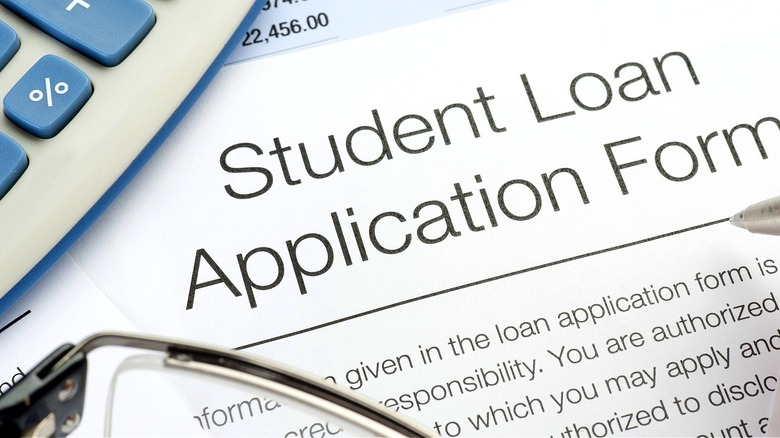How To Choose The Best Student Loan Repayment Plan For You
According to 2023 stats courtesy of the Education Data Initiative, 43.2 million students, past and present, account for $1.727 trillion in student loan debt in the United States. The average federal and private debt for each debtor is close to $40,000 ($39,981, to be exact). Since the federal debt load made up about 92% of that total, it's commendable that the Biden administration attempted to forgive around $340 billion of that before the U.S. Supreme Court forced that number down to $39 billion.
Available to borrowers of federal student loans, the Saving on a Valuable Education (SAVE) plan provides low- to middle-income borrowers with lower monthly payments adjusted to income and the size of their household. In the best-case scenario, this could whittle monthly payments down to zero or lower loan payments below other income based repayment plans. However, even Federal Student Aid acknowledges this may not always be the case, specifically if a borrower falls in a higher income bracket and can make lower payments on a more traditional plan. Either way, once you exit school because you've graduated, quit, or fall below half-time enrollment, you'll have a grace period of six to nine months, depending on your repayment plan, before having to start making payments. So what's the best repayment plan for you?
Pay it off in 10 years
If your goal is to pay off your student loans sooner than later, then a standard repayment plan or graduated repayment plan may be for you. The standard repayment plan is a fixed monthly payment schedule amortized over a 10-year period. One of the best things about having 120 fixed payments is you'll know exactly what you're responsible for every month and it'll never change. Aside from getting your loans out of the way faster, the other upside is lower interest payments over time of at least $50 per month.
Of course, the downside to paying off your loan quicker is that it means higher loan payments upfront than other plans. This is one of a few reasons why you shouldn't pay off your student loans too quickly. Most standard fixed rates right now average around 4% to as high as 16% APR. With a low student loan average of ~$37,000, that's anywhere from $375 to $620 per month.
In addition, this won't work for public service loan forgiveness since that program kicks in after 120 payments, and your debt will already be paid off. This is where having access to resources in the form of generational wealth or earning a higher income will benefit a debtor. If you decide to go this route, you'll want to stay away from college degrees least likely to pay off financially.
Pay it off in 25 years
An extended repayment plan buys you more time to pay off your student loans, up to 25 years, as long as you have over $30,000 in debt. You can take advantage of a fixed rate or graduated rate, the latter of which starts with lower rates before adjusting upward every two years. Under a graduated payment plan, you'll never pay more than three times any previous payment related to federal student loans for up to 10 years, or up to 30 years with consolidated loans. The benefit of extending your pay period is lower upfront payments every month.
The downside to this plan is you'll be on the hook for regular loan payments for a longer period of time, and you'll end up making more interest payments than you would on a 10-year plan. However, if you're carrying a lot of student loan debt, this is a viable way to ease your burden. Like the 10-year plan, this loan also isn't eligible for public service loan forgiveness, and so if that's something you're seeking, you're better off choosing income-based repayment. If you're making less money at the start of your career but see yourself gradually making more money in the future, this plan might make more sense in the long run than others on this list.
Pay it off with 10% of your income
Income-driven repayment plans are monthly payments adjusted to a certain percentage of your income and take family size into account. This can sometimes be as little as zero dollars, but the rate will also be adjusted annually based on updated income and family size. Once you've completed your payment period, anything leftover will be forgiven. That forgiveness extends to economic hardship, months where your payment is nothing, and what you owe under other repayment plans.
Revised Pay As You Earn (REPAYE) is an IDR that maxes out your monthly payments at 10% of your income, only ticking upward with your income and forgiving anything remaining after 20 to 25 years. REPAYE, rebranded as Saving on A Valuable Education — or SAVE — as of October 2023, subsidizes as much as the entire difference between your interest and your payments for the first three years of your repayment. It switches to half the difference after that.
Pay As You Earn (PAYE) is an IDR that also caps your payments at 10% of your remaining income after household expenses with forgiveness of any balance remaining after 20 years. If you've taken out a federal loan after 2007, didn't have any existing student loans when you did, or secured a direct loan on or beyond October 1, 2011, you're eligible for this plan. Just keep in mind the forgiven portion of IDRs is considered income by the IRS, so you'll pay taxes on it.
Pay it off with 10% to 15% of your income
Along the same lines as income-driven repayment plans, an income-based repayment (IBR) plan maxes out your payments every month adjusted to your income. An IBR also forgives the remaining owing after 20 to 25 years, as long as you've made your payments. An IBR plan can be set at 10% of your income or as much as 15% if you received financing before July 1, 2014. As with PAYE plans, these payments are set to discretionary income or the difference between your gross income and the state poverty line and factors in the size of your household and dependents. Like IDRs, these will be adjusted every year accordingly but will never be more than what you'd pay with a 10-year standard plan.
This is a great plan for someone not gainfully employed or unemployed since it's adjusted to your income. One hundred percent of nothing or next to nothing isn't a whole lot, so another standout benefit is the unlikelihood of your credit ever taking a hit. Assuming your biggest hurdle is approval, the rest should be smooth sailing as long as you manage your debt. We have about 17 tips for paying off debt that will come in handy for this, or any other loan or line of credit you acquire in life.
Pay it off with 20% of your income
An income-contingent repayment (ICR) is an alternative to an IDR plan if you don't meet all the qualifications for one. It'll still lower your monthly payment but is based on 20% of the borrower's discretionary income or the equivalent of a 12-year fixed payment plan, and better still, you don't need to prove financial hardship to be eligible. While this federal student loan offers the least amount of financial relief from monthly payments, you can stretch it out to 25 years to lower your payments. There's an added benefit of being able to pay down more interest than in an IDR or IBR plan. If you're interested, we have some pointers on the best way to calculate student loan interest.
We haven't yet mentioned how marriage may affect your monthly payments for most of these repayment plans — except for IBRs — come tax season. The impact on your student loan payments is just one reason married couples might want to file taxes separately. A joint tax filing consolidates your income as a household and could disqualify you from some of these plans if you go above the threshold for financial hardship. Worse than that, if your spouse earns $90,000 to your $35,000, that combined $125,000 income could change your monthly payments significantly. We obviously can't tell you not to get married if you have student loans, but maybe keep your tax filings separate to enjoy lower monthly payments.





